Tremont Temple
The Tremont Temple on 88 Tremont Street is a Baptist church in Boston, affiliated with the American Baptist Churches, USA. The existing multi-storey structure was designed by architect Clarence Blackall of Boston, and opened in May 1896. It replaced a much smaller, 1827 structure that had repeatedly suffered damage by fires.

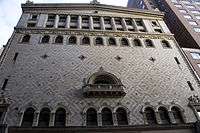
The new facility was designed with a large auditorium, ground-floor retail shops, and upper-story offices, all of which could be leased commercially so that the congregation could welcome all worshippers for free.
The building is currently under study for landmark status by the Boston Landmarks Commission.[1]
History
On 28 December 1843, the Free Church Baptists bought the Tremont Theatre, built in 1827 in Greek Revival style. They renamed it the Tremont Temple and adapted it for use for religious worship. They did not charge for attending their church and had a racially integrated congregation.
Although the building was largely used for religious purposes, it also served occasionally as the venue for public events. An Egyptian mummy was displayed beginning on 28 September 1850, and Sam Houston gave a speech there against slavery on 22 February 1855.[2] Boston had a strong community of abolitionists, both black and white. Wendell Phillips gave a speech there the day after Lincoln’s election: “the slave has chosen a President . . . Not an Abolitionist, hardly an antislavery man, Mr. Lincoln consents to represent an idea. A pawn on the chessboard. . . we may soon change him for knight, Bishop or queen, and sweep the board (applause).” [3]
The Temple was damaged by fire in April 1852; at the time, offices were occupied by music instructors, dentists, a taxidermist, and several artists: Fitz Henry Lane, Benjamin Champney, Mr. Kimberly, John C. King, B.F. Mason, Wellman Morrison, John Pope, and John W. A. Scott.[4]. It was also used for the storage of Thomas Thompson extensive art collection, largely destroyed. The temple suffered subsequent fires in 1879 and 1893 and was repaired.
The Temple was the site of Charles Dickens' first reading during his 1867–68 tour of the United States. Dickens read from "A Christmas Carol" and "The Pickwick Papers" during his two-hour reading on December 2, 1867.
The congregation called it Tremont Street Baptist Church and later Union Temple Baptist Church, adopting the name Tremont Temple Baptist Church in 1891. The Reverend George C. Lorimer served as pastor of the church for twenty-one years, interrupted by brief pastorships in other locations. He left in 1901, after guiding the congregation through construction and opening of a new building, to move to a New York City congregation.
The congregation had decided on a new, larger structure, which was completed and opened in May 1896. Designed by architect Clarence Blackall, it was intended to be a church with an auditorium and other spaces suitable for leasing for business purposes, in order to support church functions. The building originally was designed with retail stores on the ground floor and commercial offices on the upper floors. Revenue from business rents and rental of the auditorium for concerts enabled the church to continue to provide free seats to all worshippers.[5]
At various times in the 20th century, films were screened at Tremont Temple, though commercial leasing ended in 1956.[5] The auditorium was used December 31, 1985, for a staged production of the opera, The Burning Fiery Furnace, by Benjamin Britten.[6]
See also
Image gallery
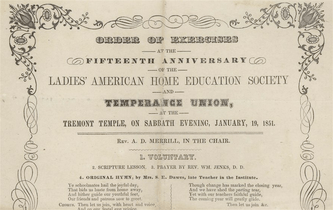 15th anniversary of the Ladies' American Home Education Society and Temperance Union, at the former Tremont Temple, on Sabbath evening, January 19, 1851
15th anniversary of the Ladies' American Home Education Society and Temperance Union, at the former Tremont Temple, on Sabbath evening, January 19, 1851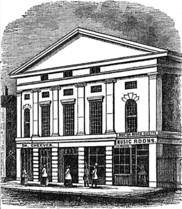 Former Tremont Temple, 1851
Former Tremont Temple, 1851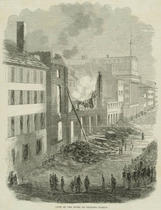 Ruins after the fire, 1852[7]
Ruins after the fire, 1852[7]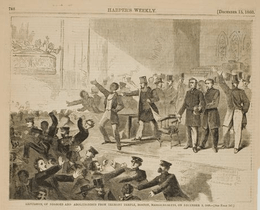 Expulsion of Negroes and Abolitionists from Tremont Temple, Boston, Massachusetts on December 3, 1860, published December 15, 1860, Harper's Weekly.
Expulsion of Negroes and Abolitionists from Tremont Temple, Boston, Massachusetts on December 3, 1860, published December 15, 1860, Harper's Weekly.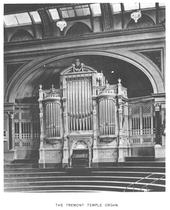 Former Tremont Temple interior, ca.1881
Former Tremont Temple interior, ca.1881 Interior, ca.1883
Interior, ca.1883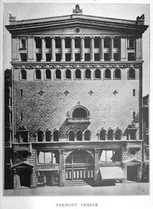 ca.1904
ca.1904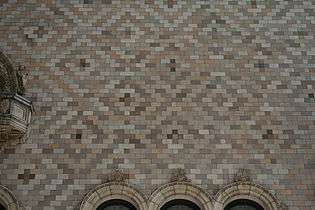 Close-up of exterior brickwork, 2006
Close-up of exterior brickwork, 2006 2007
2007 2007
2007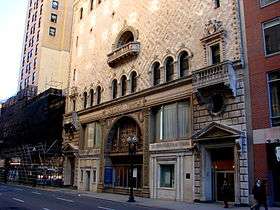 2008
2008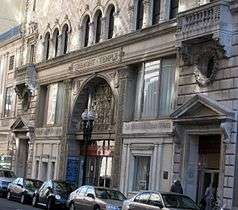 2009
2009
Notes
- https://www.cityofboston.gov/images_documents/PETSTATS_June2016_tcm3-53570.pdf
- Haley, James (2002). Sam Houston, OU Press; p 335.
- Zinn, Howard (1999). A People’s History, HarperCollins; p 189-90.
- "Destructive Fire", Boston Daily Atlas; Date: 04-01-1852
- King, Donald C. (2005). The Theatres of Boston. Jefferson, NC, McFarland & Company; p 159, p 218, p 238
- Boston Globe, December 29, 1985, p 25 newsbank.com link (accessed via Metrowest Massachusetts Library System www.mmrls.org)
- "Burning of Tremont Temple". Gleason's Pictorial. Boston, Mass. 2. 1852.
References
- Kilde, Jeanne Halgren (2002). When Church Became Theatre: The Transformation of Evangelical Architecture and Worship in Nineteenth-Century America. New York: Oxford University Press. Cf. especially p. 142
- Savage, Edward H. (1865). A Chronological History of the Boston Watch and Police, from 1631 to 1865: Together with Recollections of a Boston Police Officer, or Boston by Daylight and Gaslight.: From the Diary of an Officer Fifteen Years in the Service. Boston. Cf. p. 82, &c.
- Shand-Tucci, Douglass (1999). Built in Boston: City and Suburb, 1800-2000. Amherst: University of Massachusetts Press. Cf. pp. 153, 177, 182, 207, 209, &c.
- History of Tremont Temple - Tremont Temple Baptist Church
External links
| Wikimedia Commons has media related to Tremont Temple. |
- Map: 42°21′27″N 71°03′39″W
- Cornell Univ. Progressive Party of Massachusetts Convention Ribbon, 1913
- Flickr. Interior, 2007
- Flickr. Interior, 2008
- Flickr. Performance of Black Nativity, 2008
- Flickr. Mystic Chorale, 2009